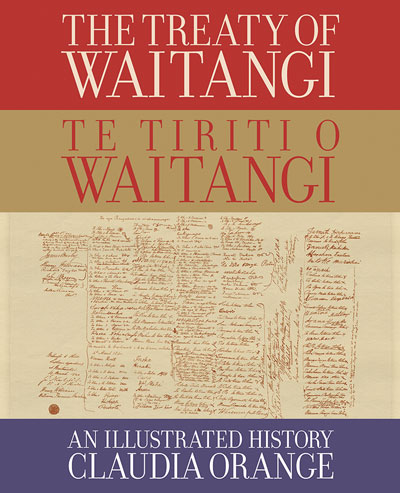Reviews
Jun 29, 2021

The Treaty of Waitangi/Te Tiriti o Waitangi: An Illustrated History
Nā Claudia Orange
Canterbury University Press
RRP: $39.99
Review nā Michael J. Stevens
 The year 1987 was significant for Māori and New Zealand as a whole. Parliament passed the Māori Language Act, thereby giving te reo Māori official status, while the New Zealand Court of Appeal defined the principles of the Treaty of Waitangi in a case centred on the State-Owned Enterprises Act 1986.
The year 1987 was significant for Māori and New Zealand as a whole. Parliament passed the Māori Language Act, thereby giving te reo Māori official status, while the New Zealand Court of Appeal defined the principles of the Treaty of Waitangi in a case centred on the State-Owned Enterprises Act 1986.
This legislative development was key to normalising and revitalising te reo after more than a century of state efforts committed to precisely the opposite. The judicial development, on the other hand, laid the foundations for the Treaty settlement process and is the basis of the Right of First Refusal mechanism that has greatly benefitted Te Rūnanga o Ngāi Tahu over the last 20 years. Serendipitously, 1987 was also the year when historian Claudia Orange published The Treaty of Waitangi. This book was more than simply well-timed. Based on a PhD she had completed three years earlier at the University of Auckland, it was thorough, scholarly and meticulous; picking up where the brilliant Ruth Ross had left off in the 1970s. Awarded the G. F. Wattie Book of the Year Award in 1988, the book has sold over 50,000 copies. Dame Claudia, as she would become, built on this success with a condensed and illustrated version of the text in 1990, coinciding with the Treaty’s sesquicentenary. A second edition of An Illustrated History of the Treaty of Waitangi was published in 2004 and Bridget Williams Books (BWB) has now released a third edition.This latest iteration – The Treaty of Waitangi/Te Tiriti o Waitangi: An Illustrated History – which will almost certainly be the last, brings the chronological narrative up to 2020 with three substantially new chapters (out of a total of 11). This additional material is shaped by 21 interviews with key participants over this period, including successive Ministers of Treaty Negotiations, Sir Michael Cullen and Christopher Finlayson, former Prime Minister Sir Simon William (Bill) English, Māori legal academic Carwyn Jones, and member of Parliament for East Coast, Kiritapu Allan. These voices add considerable value but are Pākehā-heavy and Wellington-centric.
However, that is offset by the book’s evocative and elaborately produced images – in colour and black and white – which centre Māori people and encompass most corners of te ao Māori, including Ngāi Tahu. We encounter the Ruapuke Declaration on which Tūhawaiki skilfully rendered his moko; a portrait of Matiaha Tiramōrehu; the pivotal 1907 Te Kerēme hui at Arowhenua; eeling at Wairewa; the Deed of Settlement signing at Kaikōura in 1997; the third reading of the Ngāi Tahu Claims Settlement Bill and Crown Apology at Ōnuku in 1998, and the 2017 Hui-ā-Iwi hosted by
Ngāi Tūāhuriri.
Cleverly, a representative image for our small suite of legally-recognised mātaitai is not of a pristine looking tītī island or a coastline fringed with virgin podocarp forest. Instead, it is the industrialised and degraded Mataura River: a powerful reminder of the multiple demands made of freshwater and subsequent difficulties facing our mahika kai.
The Treaty of Waitangi/Te Tiriti o Waitangi: An Illustrated History also has a large and detailed set of appendices. These draw on research Dame Claudia first undertook on Treaty signatories in the late 1980s but has continually extended, including Te Kōngahu Museum at Waitangi and the permanent “He Tohu” exhibition which opened at the National Library in 2017. This was a consequence of the Treaty sheets being digitised as well as her growing engagement with several iwi and hapū, especially in the Far North. In terms of the book, this results in high-quality reproductions of each sheet and particularly useful outlines of each signing.
Like the Treaty itself, though, this is work without end. “Kaikōura”, whose name was one of three added at Ruapuke Island in June 1840, continues to be solely identified as Kaikōura Whakatau. However, a compelling case can be made for the rakatira Kaikoareare, who signed the Wentworth-Jones Deed a few months earlier. Similar debate surrounding Taiaroa and Korako is also absent. This part of the book also includes maps of (declining) Māori land ownership between 1860 and 1939, a timeline of the Waitangi Tribunal’s first 40 years, and a summary of Māori claimant group progress with settlement negotiations up to June 2020.
Clearly, this book will be an invaluable resource for kaiako and tauira as a compulsory New Zealand History curriculum is introduced into kura for Years One to 10.
However, it is worth highlighting this publication was in train well before the government signalled its policy shift. The latest investment in An Illustrated History is further evidence of BWB’s longstanding efforts to build a better New Zealand through honest, but accessible reckonings with our colonial past. Put differently, this is not just a book for schools, universities or libraries. As with Dame Claudia’s earlier work, and so much of the BWB catalogue, An Illustrated History can and should find a home in all our homes, from Te Rerenga Wairua to Rakiura. It should be read by parliamentarians, plumbers and pā kids.
 Michael J. Stevens is the Alternate Representative to Te Rūnanga o Ngāi Tahu for Te Rūnaka o Awarua. An independent historian, he is currently co-editing volume 2 of Tāngata Ngāi Tahu and completing a book on Bluff as the 2020 Judith Binney Fellow.
Michael J. Stevens is the Alternate Representative to Te Rūnanga o Ngāi Tahu for Te Rūnaka o Awarua. An independent historian, he is currently co-editing volume 2 of Tāngata Ngāi Tahu and completing a book on Bluff as the 2020 Judith Binney Fellow.
Opinions expressed in REVIEWS are those of the writers and are not necessarily endorsed by Te Rūnanga o Ngāi Tahu.